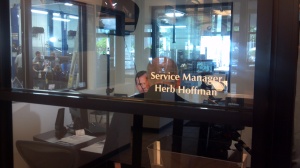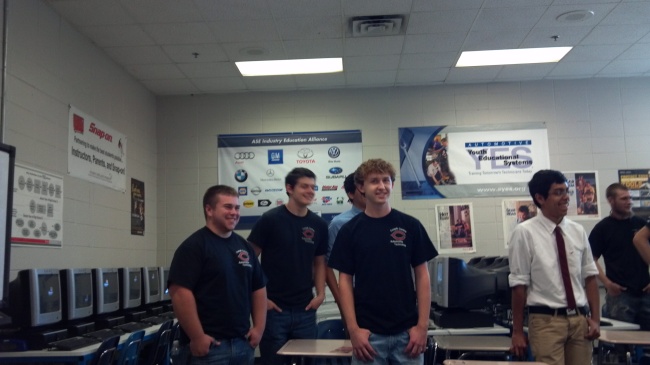February 17, 2014
Spring is almost here and soon your hard work will pay off as students graduate or move into summer internships. The value of the work-based learning experience is the result of many hours, if not days, of preparation, beginning back last year when your introduced your students to the concept. The Automotive Youth Educational Systems (AYES) school-to-career model outlined in this blog is road-tested, known and widely supported by industry leaders. The AYES model is based on the European apprenticeship and was introduced by Jack Smith, then Chairman of General Motors, in 1995. Since then, AYES has evolved to be the industry-wide model for the automotive service industry.
Today, with the affiliation of the ASE Industry Education Alliance, any NATEF-accredited secondary program can employ the AYES model for their Collision, Truck and/or Automobile technology programs. See Get Started
My colleague, Tom Richardson, one of the architects of the early AYES model, is fond of saying, “It’s all about relationships.” Remarkably simple in concept, those crucial relationships begin with the program’s advisory committee. Invariably, in my experience, at the foundation of a good auto program is a strong program advisory committee. This is especially true when it comes to work-based learning programs; arranging job sites, career exploration and job shadowing activities, identifying mentors, interviews, and intern placement. For more on development of advisory committees,read Advisory
Read what NADA has to say about AYES
NADA ROI If you are a employer reading this check out the intern value calculator on this NADA post.
Where does a quality program start? If you have a motivated instructor you are off to a good start. Good teachers always seek more ways to serve their students, improve their program and grow in their profession. Read Remarkable Program, Remarkable Teacher
Here is an AYES Mentor, an ASE Master Technician that is proud of his accomplishments displaying his ASE credentials along with his family pictures. See
Our Partners A good mentor, like a good teacher, is hard to describe. We are asking he/she to be amazing at times. You are a teacher and you have many students and a facility to keep up, but you also have support people that help you and provide structure. We are asking the mentor to teach and make their living at the same time. The mentor may have issues with their life at times also that affect them. You, the teacher, also need to be available to the mentor and intern for support when needed.
See
Advisory for more on Advisory committee development.
Let’s assume you have a good working Advisory Council that supports you and your students. If we look at a time line See
link to calender we would see that the August, September meeting would be a good place to start the hunt for new mentors. These individuals are not hard to find, yet they can be difficult to develop and turn them into stakeholders. During your visits to the franchises and retail shops in your area of operation, get to know the technicians and managers. Discover the ones that have the attitude of a mentor candidate. Look for leadership and patience, someone who is a professional, that replicated/cloned would be an asset to the business, and the community. A role model so to speak. They come in all sizes and ages, but the defining attribute is they like people and want to give back to the community the best their craft has to offer. Good mentors are teachers, probably the best example of a teacher there is. All truly good teachers are mentors. Selecting mentors is a challenge to match each one to the right intern. It takes a lot of time and is not something you do with form letters or phone calls. You have to study people, personalities and emotions.
We hold classes each spring called “Train the Trainer” for the purpose of training the teacher to work with student interns and mentors.
To learn more about T3 and sign up for the classes. Go to Train the Trainer AYES model gives you access to the documents, forms and manuals that cover every aspect of the school to career process with proven methods that work. No reason to roll your own or reinvent the wheel. We know what you need and have a proven plan for success. We know you will have problems placing 17 year olds. We have best practices we can share for that. We know you will have problems getting the attention of the right people at the businesses. We can help with that also.
I feel this summer internship in the AYES model becomes the most important experiential learning experience the student will have in secondary education. It is learning at the Master’s elbow in a contextual environment that can’t easily be reproduced in an academic based education system. It gives the student the experience without the dangers associated with winging it on their own in a career that in my opinion is unlike any other.
For the nuts and bolts of an internship I recommend you develop your paperwork to involve the business, the mentor, the intern and the parents in a clear legal chain of responsibility that covers all areas of the program. The resources on the NATEF/AYES website are time tested and very adaptable to your program. Why reinvent the wheel? You can call your ASE Alliance manager for assistance. See
Find my Field ManagerHerb Hoffman, Service Manager of Infiniti and Subaru of Gwinnett is active with the local NATEF accredited program @ Maxwell High School of Technology. Herb is very positive that the AYES model is the way to “Grow your Own” for the dealerships he manages. See
Testimonials Herb is a big supporter of Job Shadowing. Read more
Job Shadowing equals Internship Success Now some stories. I was at a dealership to talk with a potential mentor, I first went in to the service manager’s office to talk with him and get his support for the intern to be selected.
Read More Always be mindful of their time…..


These high school students are lined up to get their
ASE Student Certification and patch from their instructor during an Advisory Committee meeting in 2013. Soon they will be going to interviews, job shadowing and looking forward to their future. The instructor, Marlo Miranda at this NATEF program does a good job involving his advisory and places a lot of Juniors in industry using the AYES model. Marlo’s graduating Seniors are usually spoken for before they graduate. His Advisory Committee meetings are held at noon with a catered lunch and last one hour. They are well attended and focus on the students.
Read more on Teenagers as Interns
2008 L to R, Josh, AYES Intern, Levon Tarver BMW Tech AYES Graduate, in background Shane Brown, BMW Master Tech and AYES mentor to Levon and Josh. Josh is @ Butler BMW in Macon Georgia Levon is now the instructor of the automotive program @ Hutchings Career Center in Macon Georgia. Levon started as an intern with Butler BMW at the age of 16. Josh started at 17. The service manager and owners took the time to look past the chronological age and saw the value in these teenagers. His story is remarkable.
Read More About this young mans accomplishments.Master GM Technician George with former AYES intern Tim Jones

George a GM Master Technician @ Walker Olds Cadillac GMC in Carrollton Georgia on right with Tim Jones who was one of the first placements out of a new AYES program. Tim is now a GM master and working with new students at the dealership. George mentored many students in his career. Not all worked out as Tim did.
Read MoreGeorge explaining the GM service information to two job shadowing students. GM and many of our Alliance partners share service information with NATEF schools using the AYES model.

T. K. McKinney at her internship @ O’Reilly’s. This student went to work at age 16 in her first internship
Read her story here 
These stories are not unique to my experience. Instructors using the AYES model across the nation see success and sometimes problems. We welcome you to join with us to develop the next generation of students in the transportation industry.
I hope you are interested in adding AYES model to your NATEF program. Or you are looking into NATEF accreditation for your school. Give the NATEF or the AYES office a call. We are always ready to help the pursuit of excellence in Automotive education. For more information on our Alliance, Go To
The ASE Industry Education Alliance Family of OrganizationsAYES model is open to any NATEF accredited Automotive Collision, M/HD Truck program in a secondary school.
Tags: Advisory Committee, ASE, Automotive, Automotive Education, Automotive School, automotive service technology, Automotive Teacher, Automotive Training, Automotive Training Online, AYES, Best Lab Practice, Career and Technical Education, Mentor Intern, NATEF, SkillsUSA, Work based learning
Posted in AYES | 2 Comments »
February 1, 2013
Transportation Education Foundation of Georgia organizes the Career Expo for the Georgia State SkillsUSA Conference to be held March 21, 22 @ the Georgia International Convention Center. This is one of our best kept secrets in Career Education. You and your company need to be involved in this awesome gathering of career focused young people.
Here is a report from the TEFGA .org site on last year’s Expo:
The 2012 SkillsUSA Career Expo and Championships was a huge success with over 7,000 participants. TEFGA _2013TEFGA Fact Sheet helped to organize the largest student focused career expo in the state, in which for two exciting days students are able to explore different career opportunities within the transportation fields, network with industry representatives and discover the options available for post-secondary education. The best students from across the state competed in competitions to test their transportation knowledge. These contests ranged from Automotive Service Technology and Collision Repair to Diesel Equipment Technology to Fight Operations and Aviation Service. Other contests tested student’s knowledge of small engines and marine and motorcycle service. The results were students realizing their goals and being rewarded for their hard work, through prizes, recognition and often scholarships for additional education.
To see the top teams in the nation compete http://www.hotroddersoftomorrow.com/ Georgia has three of the top five teams for 2012.
The Georgia SkillsUSA Conference http://www.skillsusageorgia.org/
To volunteer to work with the expo, To have your company showcased at the expo, To meet some of the best young people focused on technical careers contact Erin.
For more information on how you can get involved in TEFGA’s activities to build Georgia’s future workforce in the transportation industries, please contact Erin Studstill:


Email: erinstudstill@tefga.org
Click on the links for more information.
SkillsUSA_CareerExpo_Flyer
Video from 2011 Expo and Skills Conference, http://tefga.org/Videos.htm
http://tinyurl.com/2013-SkillsUSA-CareerExpo
TEFGA Expo and Skills Sponsorship Form
2013TEFGA General Donation Form
Tags: Automotive Education, automotive service technology, aviation, career expo, Careers, cars, diesel equipment technology, Hands On, SkillsUSA, TEFGA, transportation, Work based learning
Posted in Auto Teacher, Automotive Education, Career and Technical, education, Education, February 2013, SkillsUSA, SkillsUSA, TEFGA, Uncategorized | Leave a Comment »
November 9, 2012
NATEF Workshop for Georgia Teachers. November 1, 2012

Georgia Department of Education Program specialist Ms. Carol Burke presented the latest news to the teachers and explained the grants available for program accreditation. New this year is funding from TEFGA for the cost of NATEF accreditation application, manuals and site visit.
24 Georgia automotive teachers and administrators attended a NATEF (www.natef.org) workshop on industry accreditation at Hutchings Career Center in Macon Georgia. The event was hosted by TEFGA (www.tefga.org) Automotive Teachers from post secondary Technical College System of Georgia and DOE Secondary schools received a update on the the new model for NATEF and AYES from AYES South East Field Manager Sonny Reeves. DOE Program Specialist Ms. Carol Burke presented to the group about opportunities and news from the DOE and TEFGA. New updates from NATEF are on this site http://www.natef.org

24 of Georgia’s automotive teachers and administrators attended the NATEF Accreditation update workshop from high schools, career academy and technical colleges.
Highlights of the workshop are the ASE Student Certification, http://www.asestudentcertification.com/
The NATEF 2012 Standards and task lists for MLR, AST and MAST. these are on the New NATEF site www.natef.org
Presentation on the TEFGA Expo by Ms. Burke, video http://youtu.be/umMlFYjpfxU
The AYES model for interns and mentoring www.ayes.org
Contact information cburke@doe.k12.ga.us sonny.reeves@ayes.org
Posted in ASE, Auto Teacher, Automotive Education, AYES, Career and Technical, NATEF | Leave a Comment »
May 19, 2014

A container of caustic carburetor cleaner. No MSD sheet or protective gear.
I wish all these pictures were photoshopped and not taken in high schools and tech colleges that are the training centers for our next generation of techs and service employees.
No I will not say where these are taken. I am invited sometimes to visit auto training programs and often asked by the administration to take a look. I am asked to tell them if they should continue to fund the program or hire another teacher. All of these are the Bad and Ugly of programs. The good have been reported on earlier in posts and there are many fine, high quality programs with motivated instructors. Sadly these “Hobby Shops” are out there and have been going for years. Most of the ones where these pictures come from have been closed or have been overhauled. On these visits I have permission to video and take pictures. I then cite the safety reasons, NATEF standards and generate a report for the administrators.

Incandescent glass bulbs should never be used in any shop. Even rough service bulbs heat up and can cause burns and fires.
Just got this http://youtu.be/T7ESQzY6spI please get rid of any glass incandescent lamps, drop lights etc. Is your lab or student worth a cheap light? Thanks Bob!
Yes the incandescent bulb will cause gasoline to explode if a drop gets on it when hot. Several shops burn every year due to the use of these. The hot metal of the frame will burn skin if touched by a hand or arm. Yes the handle on this light is taped up from a previous pulling out of the cord. IMHO these types of lights have no place in a lab. I know personally of two retail operations that burned due to the employees use of these lights. I see these in labs. Please get rid of them and use something that will not harm a student.

Yes that is an old fuel tank under the tires with some type of caustic carburetor cleaner in the 5 gal container. The MSDS on the Carb cleaner was not found but later I looked it up. Very harmful on contact with skin or eyes. No Personal Protective gear such as gloves were found. I asked what it was used for and was told the students clean parts with it. This cleaner is a hazardous materiel and must be disposed of properly

Note the wire brush has no safety guard. I assume the chair is for sitting if you get tired working? The grinder was not bolted down and there was no sign of eye protection or face shield. You know a wire brush sheds wire if you have ever used one. If you use one of these wire brushes on a grinder or power tool note that old brushes rapidly shed the wire pieces and they will stick in clothing and skin. Hate to know what they do to an eye. I suggest if you have to have one of these you replace it regularly and have a full face shield for the user. The stack of old tires is a disposal problem, certainly only a few are needed for instruction.
Safety of the student is paramount in any evaluation of a program. If a student is injured during the lab time no matter the cause or outcome, the accident is a problem for the instructor. Even minor issues that are bound to happen like small cuts and such are a hassle. Some instructors have gone their whole career without a serious incident. Operation of an training lab involving sharp objects, extreme temperatures, moving, rotating machines, hazardous chemicals, flammable liquids and gases and high voltage circuits is difficult in a safe organized shop. Teaching in the environment shown here in these pictures would be next to impossible.

This exhaust hose reel is missing the hose. Running an engine in the lab requires the use of exhaust extraction. Passive systems may work but I doubt the effectiveness on all application. Every time I have observed a passive system in use, the students complained of head aches. This is due to CO as the first symptom is headache.
The tire machine is not bolted down. I assume the acetylene torch set keeps it nice and secure?


A face shield would be nice. So would proper storage of consumables.
Lot of these older brake service machines give good service, but this one has no safety guard. Note the storage or lack of it. Consumables everywhere in this lab.

Top heavy machines can tip over and should be bolted down.
Any equipment that is designed by the manufacturer to be bolted down needs to be secured. Floor stripe is history
Looks like the Exxon Valdez looking for a place to land. What many school systems don’t realize is that OSHA and EPA can fine them for things like this. Besides being a fire hazard the training of future techs is being done here with this as an example to them.
At least they have a spill containment even if it grossly overloaded. The people at http://www.thenewpig.com can advise schools on what is needed to be compliant. Two students were recently seriously injured at a High School auto shop that was NOT accredited. see http://tinyurl.com/kbezo38
I was called to one of the new Charter School known as County Academy Center of Technology. Well the name does not make the insides better. This program had been transplanted into a new building and the administration wanted to know why enrollment dropped from when it was at the high school. Anyone that understands children as teens knows they hate to give up their peer group and move to a new school that has no sports or clubs like a comprehensive high school. These programs can become dumping grounds for the feeder schools. This was the lift that was being used. The welds were broken on the safety latches and this prevents the engagement of the locks for the arms. All four lifts were broken. While there I observed students working with no safety glasses on under the lift. I explained this to the administrator as a safety violation that could put him in jeopardy. Lifts should be certified every year.
.

Rust streaks tell the age of the broken safety latch
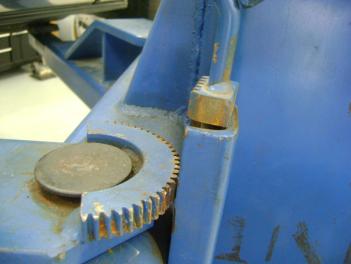
This lift is also broken. Improper placement of lift and raising a vehicle not set up correctly caused the arms to force the safety locks. This lock no longer lines up.

Skateboard!
Clutter. Disorganized storage areas waste instructional time. Flammables are safer stored in lockers designed for containment. Teaching students proper organizational skills is a part of the operation of a lab. I am sure an advisory committee will appreciate a clean well organized lab for the training of their future employees
The same lab had tools and equipment scattered.
This lab was shared with a tech college for a night class with an adjunct instructor. I have not seen this type of program work anywhere. The adjunct instructor often as not is a by the hour paid teacher and has no “Buy In” towards the program. Often time they are working for a college nearby and must keep up their own lab also, they simply don’t have the time.
Here is an air bag, battery and assorted parts on a steel table. This project had parts over a wide area. No lab job sheets, task sheets or performance tests means there is a hobby shop atmosphere.

Use project boxes for lab work that will be left over to next day.

Gasoline storage is only allowed in approved storage lockers. Not in tool room.

Batteries are in top right corner and air bag was live
The tool room had no organization and several gas cans with fuel in them. Parts bins can be used for projects. This hobby shop had none visible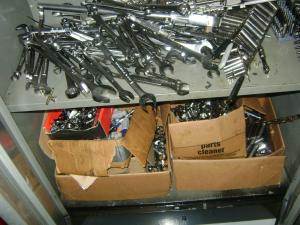 I opened a locker and found these tools. The administrator continually said how good the instructor was. We asked for safety glasses while we were there and the instructor left the room to find some. He never returned before I left.
I opened a locker and found these tools. The administrator continually said how good the instructor was. We asked for safety glasses while we were there and the instructor left the room to find some. He never returned before I left.

No Flammable locker and gas cans all over. Has no one ever seen a gasoline fire?
Clutter makes it hard for students to find the right tool or the part they were using. When I observe a lab like this I know that the instructor is overwhelmed and overworking because of a lack of organizing skills on the instructor’s part. Safe operation of this lab is almost impossible. No wonder the turn over for auto teachers is high.

The main issue here is all the electrical demands of the shop floor are fed by the extension cord plugged in on the center of the wall. There was no organization of any of the tools or equipment.
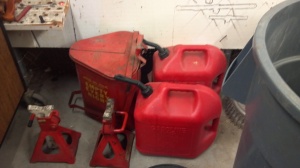
This is right in the lab with a plastic trash can nearby to add to the mix. These plastic trash cans give off poisonous fumes when they burn in the lab. Nice !

This school is in a very well off county with lots of tax dollars. Seems the school board wanted to close the program. I was asked to evaluate the program. Over 60 auto dealers with in 20 miles and the only contact was a few phone calls to invite the dealers to an open house a few years ago. The teacher had been cut to half time.

The instructor had cleaned up for my visit and had hauled off many truck loads of junk left over from a teacher that had retired. The admin of the school just wanted the problem to go away. This one is closed now.

General clutter with no organized learning area. Hard to tell if anything safe can be accomplished.

Outback we find oil drums with unidentified liquids in them. Who is responsible?
Outback and in Sight, Used Oil and Safety Glasses or How many lawyers do you know?

A tool locker for special tools?
Special tools are just that “Special” Students should be taught that they command respect from their users.
Instructors should realize that every tool should have a place identified and well marked with the name of the tool, operation manual included for proper storage of the special tool. The assumption that any student would know how to find or use a special tool is, well foolish.

This lab was considered by the administration to be the best possible . This clutter was here on two separate visits.

This lab is totally redone with new equipment and quality instructors. On the day of the visit when this was taken the school resource officers arrested a student with drugs in the lab. Now on the advisement from the advisory committee new teachers were hired and the program is now one of the best.

A classroom in the lab area is sometimes unavoidable. While not the best situation. Safety Glasses must be worn by all persons in the room when work is being done. This program had lost their accreditation a few years before this picture. The program has since been totally overhauled.
The schools often don’t see the safety issue as some unsafe practices are accepted in industry believe it or not!

Outside storage is cluttered and unused parts seem to collect in these places.

Here you have a old valve machine, a differential out of something and two cans of AC refrigerant along with a grinder missing guards and brake drums. The point of this picture is that there is no instructional organization.

An antique machine that never caught on to handle a very hazardous material.
Tags: Automotive, Automotive Education, Automotive School, automotive service technology, Automotive Teacher, Automotive Training Online, Best Lab Practice, Career and Technical Education, CTAE, NATEF, Teacher, Teaching
Posted in Automotive Education, Career and Technical, NATEF, NATEF Accreditation, Uncategorized | 2 Comments »
February 20, 2014

Tomira McKinney or TK as she likes to be known was a student at Hutching’s Career Center NATEF accredited AYES program in 2005 when I met her, Raised by her mom and a child of Macon’s inner city she was not a good student at first . Time and patience worked on her and soon she became the service and parts “manager” for the “Shop” during our lab class. A store manager came in one day to deliver parts and met TK as she handled the parts order. The store manager was delivering the parts to the school and came over to me and asked “Can I hire her?” I said “Sure! but she is only 16.” He said ” I don’t care she is better than anyone in the store I have now” After an interview and job shadowing. TK served as a paid AYES Intern in the O’Reilly’s store that summer and then the next year continued until graduation at the store on Vineville street in Macon Georgia. The last report on her was a call from TK in 2011. She was in Atlanta moving up into the management of several stores for O’Reilly’s.
These stories are not unique to my experience. Instructors using the AYES model across the nation see success and sometimes problems. We welcome you to join with us to develop the next generation of students in the transportation industry.
I hope you are interested in adding AYES model to your NATEF program. Or you are looking into NATEF accreditation for your school. Give the NATEF or the AYES office a call. We are always ready to help the pursuit of excellence in Automotive education.
Tags: ASE, AYES, NATEF, Skills USA, WBL
Posted in Uncategorized | Leave a Comment »
February 20, 2014
George a GM Master Technician @ Walker Olds Cadillac GMC in Carrollton Georgia on right with Tim Jones who was one of the first placements out of a new AYES program. Tim is now a GM master and working with new students at the dealership. George mentored many students in his career. Not all worked out as Tim did.
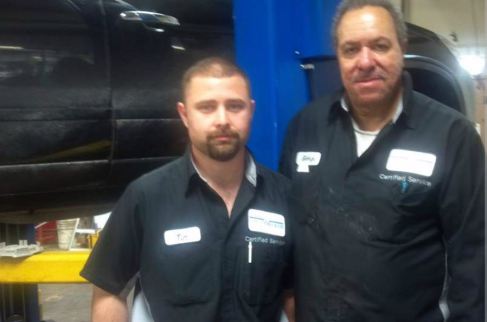
George explaining the GM service information to two job shadowing students.

GM and many of our Alliance partners share service information with NATEF schools using the AYES model. Exposing the student to different systems is good practice for motivated young techs.
George agreed to take on an intern the summer before Tim. His name was Milton, as a Junior Milton had all the things you look for, good attitude, teachable, respectful and he and George were a good fit. Senior year Milton continued to work at the dealership and made enough to buy a used Cadillac. Well one weekend night coming home late he crashed the Caddy and wound up in trouble, lost his license and therefore his job. He was unhurt but because of the speeding ticket and wreck the dealership could no longer use a automotive tech with out a license to drive.
Posted in Uncategorized | Leave a Comment »
February 20, 2014
Picture: Teenagers lining up at an Advisory meeting to receive their ASE Student Certifications. All the students in black tees are AYES interns that were hired at 17 for their first career position in the automotive industry.
We are asking the mentor to take on a teenager. Now that statement brings mixed perceptions to the table. The people you are trying to convince to take a teenager may think back to their teen years or their teenagers, or imagine that your students are like all the bad news @ 6 stories they hear. They will say “No”, citing rules, insurance and every excuse under the sun. They know they need help, The service bays are full now and the baby boomers are not getting younger. Well I have a word for those that say “No” to your students. They need to “Know” more about your students. An AYES prospective intern has passed your rigorous demands in the classroom and lab. They have met the standards set by the ASE Industry Education Alliance partners. I encourage you t go back to those that said no with the plan for using the AYES model, ask for job interviews, ask them to visit the lab and observe students, Ask and continue to ask. Some of my best placements came from the strongest resistors to hiring a teenager.
One of the common objections comes from a misunderstanding of the rule about operating lifts. The law talks about lifts and those are the huge lifts used in manufacturing and transportation to lift many tons of material. Not the common auto lift in shops and your lab.
Contact your ASE Alliance Manager and we can get you insurance letters to help clear this up.
Some time a shop won’t hire teens because of a business rule about liability. We have some schools that require interns to purchase school insurance like the football team does to protect them in case of an off campus accident.
Tags: ASE. NATEF, AYES, WBL
Posted in Uncategorized | Leave a Comment »
February 20, 2014
I could look out over the shop from his office and see the various work stations and technicians in the service bays. The closest one was a new SUV that had just been pulled into the lift bay by a tech that proceeded to set up the twin post lift by setting the arms under the vehicle at the lift points. He set the left rear and left front then as he walked around the front toward the other side he got a cell phone call and answered it as he set the right front lift arm. I was not paying much attention as the technician walked around to the lift control and with his back to the vehicle and continued his call as he lifted the vehicle. I did notice the SUV bounced when it first hit the floor on it’s rear hatch. The service manager was instantly shocked! Before he could speak, I said “Seeya! I will come back when you are not so busy.” Fortunately no one was hurt.
Here is a reminder:

Tags: https://autoteachersonny.files.wordpress.com/2014/02/think.png
Posted in Uncategorized | Leave a Comment »
February 20, 2014
I placed a student at a Mercedes dealership. Josh, a junior is a good student, respectful and motivated. The service manager, James, was hard but fair. We the WBL coach and I had worked many hours to convince the dealership to hire a 17 year old. We knew if this young man did not get a job soon he would move on to another career as the family needed income. The local fast food places were hiring kids all day @ $7.50 an hour and giving them 60 hours of work. That is hard to compete with in a shop that only goes 40 hours. The dealer finally approved the hire and Josh was in. The mentor was selected and Josh was at this first real paying job working as an intern to a Master Mercedes Technician. His mom was so proud of him. The first week went well. The second week James was out for a vacation day and the mentor assigned to Josh called in sick. I got the phone call around 2 pm. “We are firing your student, Mr Reeves” said the assistant service manager. What happened?
2008 L to R, Josh, AYES Intern, Lavon Tarver BMW Tech AYES Graduate, in background Shane Brown, BMW Master Tech and AYES mentor to Levon and Josh. Josh is @ Butler BMW in Macon Georgia Levon is now the instructor of the automotive program @ Hutchings Career Center in Macon Georgia
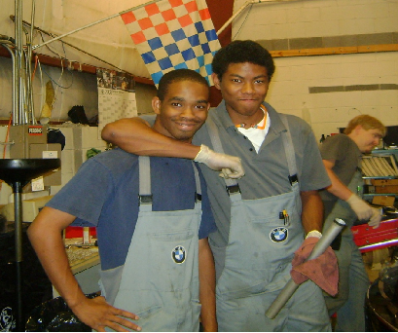
The case was this. Josh was working with another tech he did not know well, when the assistant service manager came to the tech and told him a service was due on a car in the Service entrance, they both told Josh to go get the car. Now Josh was 17, he knew he was not to drive any vehicle. He had a drivers license but all AYES interns are told “No driving the cars!” His mentor knew this, James knew this, everyone except the two adults telling Josh to go get the car NOW! Josh did what he hoped was the best to try and please the immediate adult requests and almost totaled a new Mercedes E class on the side of the dealership doorway. Should he have called me first? Yes, but his cell phone was locked up in the office as per the rules of the workplace. Should I have made sure everyone knew the rules? Yes, but some how these two were not informed.
Josh did lose his job and I was called to the dealership the next day by James. There I met with James, Josh and Josh’s mom who was very upset. By being there I feel I helped smooth over a potentially negative situation as the mom was not happy with the dealership policy and firing of Josh. The AYES model recommends that you the instructor visit students during the summer internship on a regular basis. “Inspect what you Expect”
However, Josh was hired the next fall to work half days after school by another dealership and is still there after 10 years. He has not wrecked any more cars. “All’s well that ends well.”
Tags: ASE, AYES, NATEF, WBL
Posted in Uncategorized | Leave a Comment »
February 20, 2014
Hi
I will attach a few documents, of course you can find them on the web site under Resources.
http://www.ayes.org/Private/My-Resources/Resources-Documents/Document-Center.aspx
Job shadowing and interviews are a rewarding part of the AYES model. I will say it is a key game changer. Students often come out of the interviews with new excitement. For many it is their first contact with an adult from the real world so plan the interviews carefully in cooperation with your advisory committee. Job interviews should be conducted over the course of several days so that potential employers can be engaged at their convenience. Students should be prepared for the interviews by using tools like Skills PDP which is no cost to AYES programs. Student should be coached and prepared by day to day work ethics preparation that you are already using to prepare them for the world of work. The ideal time for job interviews is winter so that students are ready for job shadowing during spring break. The interviews can be a win+win for the student, employer and the teacher. The student many times comes away with a new found respect for themselves because a perspective employer gave their time to focus on the student. The employer often finds that their outlook on teenagers is changed by meeting your qualified students. The instructor often finds that the students rise to the occasion and become better learners because of the exposure to the employers.
Job shadowing is reserved for students that meet your expectations on all levels. I have attached the AYES student standards. For me to sign off on a student means that I am placing my reputation on the student meeting the expectation of the employer. Where the school system may have a person that supervises school to work students. I feel they are focused on numbers and not quality. I would always cooperate with the person in that position,But I would not allow them to place my students. The AYES model is built around the foundation of a mentor. The mentor is key to successful placement of interns. These documents outline the Mentor/Intern relationship. http://www.ayes.org/Private/My-Resources/Resources-Documents/AYES-Manuals.aspx
Job shadowing requires selection of the work place and should be planned in detail with the personnel at the job site understanding the role each has to play in the student’s introduction to the workplace. Ideally a student will spend a few days at one work place, shadowing several employer positions. I would give students a guide to journal/write about each position they shadow. I would suggest you coordinate the interviews and job shadowing to follow the school’s calendar to take advantage of holidays, teacher work days when student are off and other windows of opportunity. A cooperative administrator at the school may give students release during school days if you can measure the student’s performance. I would gauge the time a student job shadows by the needs and requirements of the supervisors at the work place.
You can download the documents and edit to suit your needs http://www.ayes.org/Private/My-Resources/Resources-Documents/Internship-Forms.aspx
Be sure that all the stakeholders are aware and sign off on all the required paperwork to cover responsibilities, liabilities and steps involved. The list would include but not limited to: Student, parent, school admin, instructor, employer and prospective mentors/active mentors.
I have observed many times that programs that job shadow/job interview a large number of students also place a large number of students in summer internships. I have also observed that an active advisory will increase the number of students employed
Of course you are the most important piece of the puzzle. With out your hard work nothing gets accomplished.
Here are some stories for you: https://autoteachersonny.wordpress.com/2013/06/03/developing-a-program-advisory-committee-2/
Any questions?
Posted in Uncategorized | Leave a Comment »
February 20, 2014
Michael now a master Honda Technician @ Walsh Honda. Micheal is another AYES model success story. Shown here with Mary Beth, one of the finest Work Based Learning coaches I ever worked with. Michael is pictured with his new Snap On toolbox. See
Snap On Tool Scholarship Your school may have a work-based learning teacher or coordinator assigned to work with student and employers.
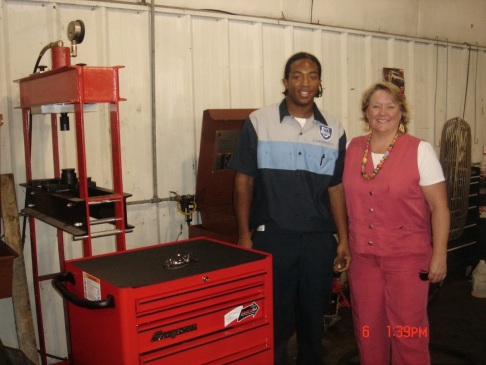
Build this relationship with the focus on “What is in the student’s best interest?”
Many times student job placements are based on quantity over quality. In an ideal AYES intern placement the student is paid a rate set by the advisory council before hand. To some the word intern means unpaid, but we want our automotive students to be paid at least a minimum if not better to reflect the quality of their work and contribution to the business. Job interviews are set, job shadowing follows and interns are selected and paired with mentors. This model is sometimes different for the WBL coach. Make sure you understand each others roles and responsibilities. Build a relationship by first understanding what they have to do for the system. The Steven Covey Quote ” Seek first to understand” works best. What their job is and understand that you have a role that can help them look very good with the AYES model and resources. Read more on developing relationships
Tags: ASE Work Based Learning, AYES, Internships
Posted in Uncategorized | Leave a Comment »
September 13, 2013
A very good young teacher I visited recently told me he was having problems with his advisory committee meetings. It seems his supervisors want to have central meetings with all the advisory councils combined. This is the surest way to kill an Advisory Committee. I will take out references to his name and share the note I wrote him.
Hi new Teacher,
I am very proud of your accomplishments, your use of technology is outstanding.
You asked me about Advisory Committees as you know when I was a teacher like you I had a very good active advisory which after the instructor first, is the foundation of a dynamic Career Technical program. You may recall that the Business and Education Advisory council for the Automotive program at Hutchings was composed of 38-44 people covering all interested industries, and the business community in Macon. The meetings were well attended and you might find the Mayor and automotive Industry VIPs from as far off as California and New York such was the interest in the program. see
http://www.schooltube.com/video/21bfb1980a694e83a98e/AYES%20B&E%20Meeting Video of last meeting I hosted. You can see some key people here at this meeting along with the mayor.
Here are some tried and true rules and guides for a strong advisory council for your program. There are many more and a guide on the NATEF web site. Here are the ones I feel you are asking about.
Automotive people are very busy and must know, What’s in it for me? They have to see the return on investment. Unless they have children in the system/school they could care less about the scores on the test of the month or the rising/falling grades. Even though many times the dealerships are the largest tax generators in the county they just don’t understand education. Making them sit in a meeting while educators/administrators talk “Ed Speak” for an hour or more kills their interest and they Won’t be back.
Do not call them on the end of the month or the first, don’t call them after 4 pm or before 10 am, They are busy with customers. Don’t schedule a meeting during those times, it won’t work!
A Tuesday or Thursday lunch meeting in the middle of the month with a guaranteed hour only for the meeting was my promise to them. 11:30 to 12:30 will work best.
Evening meetings are OK but you have to plan on after 6 pm and again only an hour. Attendance was always less. For 16 years of having four meetings a year I will say that a lunch meeting works best. Plan the agenda to meet your NATEF requirements carefully. Send the agenda items by email or snail mail or better yet hand deliver and have a chat with the member at least a month before the planned meeting. It is good to hand deliver a printed invitation. I would then visit for a few minutes at least a week before as a reminder and to possibly answer any questions about the agenda. A phone call to remind them is good the week of the meeting and then a call in the AM of the meeting day. I always had a poised articulate student do the calls for me on the day of the meeting. Always remind the attendee that they are important, this is their training program and they and any employee or supervisor is welcome.
The Culinary Arts program catered the meetings and that worked very well. Actually the quality of the meals was aways a hit with the members. They were impressed with the students and the food. During the meeting my students would video the meeting and take pictures as the meeting went on. Several times the Mayor’s photographer came and did a photo shoot. After the meeting ask if any want to tour the shop and observe a class in session. This gives the members a chance to meet the high quality student you have.
The key points here are these advisory councils will grow and succeed on your efforts. They are the stakeholders by virtue of the tax they pay. They should learn that your students are the “Farm Team” for their “Major League” businesses.
Explaining the features and benefits of your students and their training will open their eyes to the resource you can be as the filter and proving ground for their future employees. An active advisory can be such a benefit to your students it would be a shame to abuse the members with poorly planed meetings that do not meet their business needs. You have been in the real world of work, you know how it works. Common sense approach to people that answers the Whats in it for me? question will always be better than asking the business person to come to the school just because some one wants to check a box off on a form to go in a file cabinet. Just as you have transition from a technician that teaches to a teacher of technicians, you must convert business people that attend into stakeholders that will support, promote and give student opportunities.
You can also visit this article for more tips on successful Advisory committees
I hope this helps.
Enjoy! Create! Share!
Tags: Advisory Committee, ASE, Business and Education council, NATEF Advisory Committee.AYES
Posted in Uncategorized | Leave a Comment »
 These high school students are lined up to get their ASE Student Certification and patch from their instructor during an Advisory Committee meeting in 2013. Soon they will be going to interviews, job shadowing and looking forward to their future. The instructor, Marlo Miranda at this NATEF program does a good job involving his advisory and places a lot of Juniors in industry using the AYES model. Marlo’s graduating Seniors are usually spoken for before they graduate. His Advisory Committee meetings are held at noon with a catered lunch and last one hour. They are well attended and focus on the students. Read more on Teenagers as Interns
These high school students are lined up to get their ASE Student Certification and patch from their instructor during an Advisory Committee meeting in 2013. Soon they will be going to interviews, job shadowing and looking forward to their future. The instructor, Marlo Miranda at this NATEF program does a good job involving his advisory and places a lot of Juniors in industry using the AYES model. Marlo’s graduating Seniors are usually spoken for before they graduate. His Advisory Committee meetings are held at noon with a catered lunch and last one hour. They are well attended and focus on the students. Read more on Teenagers as Interns


